Long before Where In The World Is Carmen Sandiego or The Oregon Trail, there was The Sumerian Game.
Designed in 1964 for classrooms, it was as innovative as it is forgotten.
I discovered this long lost obscurity while doing research for a years-long project about the early history of storytelling in video games (which you can support on Patreon if the topic interests you). To my surprise, I’d reached the end of my journey to find the beginning, because this is where storytelling in video games starts.
The Sumerian Game was the first narrative video game. And the first video game writer was a woman named Mabel Addis.
How The Game Was Played
The student sits down at an IBM 1050 terminal connected to a time-shared IBM 7090 mainframe computer and a slide projector. But before the game starts, they player is introduced to the world of Sumer via a slideshow synchronized to a cassette tape.
The first unskippable cutscene! Albeit, not an in-game cutscene.

After the introduction, you’re informed that you’re now the ruler of the Sumerian city-state of Lagash. As ruler, you make resource management decisions in order to keep your kingdom healthy. Your steward delivers regular status reports on the state of the kingdom, and then executes your royal commands.
Total population now 500 Total farm land under cultivation, acres 600 Total grain in inventory, bushels 900 one season old 900 two seasons old 0 three seasons old 0 Total grain just harvested, bushels 13000 Total resources, harvest + inventory 13900 You must now decide how to use your resources. How many bushels of grain do you wish to FEED your people? 1000 How many bushels of grain do you want PLANTED for the next crop? 2000 This means that 10000 bushels must be placed in storage. Is this all right? Do you wish to 1-let your decision stand or 2-revise them?
The computer plays the role of your court advisor, offering you suggestions and keeping you informed when situations arise.
The steward will execute the royal commands and return in 6 months. Sir. your people don't have enough food to eat and there are 1301 bushels in storage. Shall we not distribute it to them? How much? 500 Sir, I am sorry to report that 150 bushels of grain have rotted or been eaten by rats this past season.
Even when quizzing you, the computer doesn’t break character:
I lean heavily upon your wisdom, Luduga, but I am also here to help you. Tell me, if your population is increasing, would you expect the quantity of grain fed to your people to 1-increase 2-decrease? 1 Of course it should increase. Forgive me if my questions seem simple. It is my duty to urge you to see the relationship among the items in your Steward's reports.
After playing through an abbreviated six months in the life of Luduga, you begin a new chapter as Luduga II, and then as Luduga III, each with new variables to deal with. Slides are shown throughout, and there are occasional breaks for additional cassette-driven cutscenes.
Although The Sumarian Game wasn’t the first resource management game for computers, it was the first one designed for elementary school students, making it the first “edutainment” game as we know it.
Previous management games were business management games written for adults, and made no attempt at telling a story. They typically used the computer as little more than a glorified calculator.
Admittedly, The Sumerian Game did start out a little bare, though even the early versions at least included the steward. But it was an extensive revision during the summer of 1966 that really transformed it into gaming’s first narrative experience.
For that, we can thank Mabel Addis.
Mabel Addis
Mabel Addis was a school teacher at Katonah Elementary in New York who clearly enjoyed writing plays each year for her students.
Although the Sumerian project was initiated by IBM’s Bruse Moncreiff, Mabel Addis is credited with writing and conducting it, with IBM’s William McKay programming it. Which means Mabel Addis is officially the first female video game designer.
But more significantly, she’s the first writer on a video game, ever.
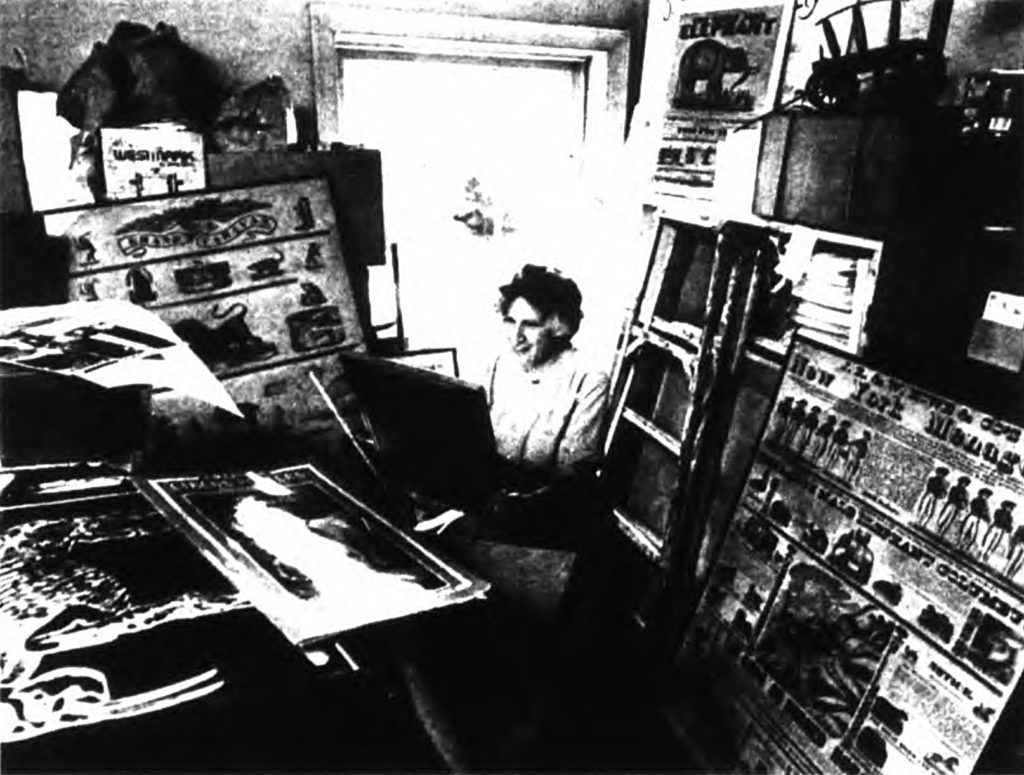
Now, some may argue that this was more of a computer game than a video game. And that’s true, to an extent. After all, computers back then didn’t use monitors, they were attached to printers. Even the original version of The Oregon Trail was played using a printer. It had no graphics, only text.
But the term “video game” is a lot more broad today than when it was first coined, at least in the US. Originally video games were specifically games played on a CRT monitor. But today we’re fine with video games existing on projectors, or vector monitors, or even HDTVs!
And besides, most of these Teletype games were eventually played on monitors anyways. The Sumerian Game is no exception…though its journey involved an unexpected game of telephone.
King Of Sumeria
Doug Dyment was a Software Support Manager at DEC (Digital Equipment Corporation) in Canada in the ’60s. After giving a talk at a university in Alberta, a grad student described to him a program called The Sumerian Game.
“I thought that this would make a good demonstration program,” Dyment told me. “The game as I wrote it was titled King Of Sumeria.”
Compared to The Sumerian Game, Dyment’s game was much more bare-bones. It lacked any flavor text or narrative elements, focusing on just the resource management.
HAMURABI: LAST YEAR = 0 STARVED, = 5 ARRIVED, POPULATION IS= 100 THE CITY OWNS= 1000 ACRES. WE HARVESTED = 3 BUSHELS PER ACRE; RATS ATE = 200 BUSHELS,YOU NOW HAVE = 2800 BUSHELLS IN STORE. HAMURABI: LAND IS TRADING AT = 21 BUSHELS PER ACRE; HOW MANY ACRES OF LAND DO YOU WISH TO BUY? :50 BUSHELS TO USE AS FOOD? :1000 HOW MANY ACRES OF LAND DO YOU WISH TO PLANT WITH SEED? :500
“The whole point was to squeeze as much functionality into a 4K computer as possible, and I used every short cut and programming trick I could think of to do so…legibility be damned,” Dyment explained.
“The final program, as listed, was the largest piece of FOCAL-8 code that could fit in a 4K machine: there was literally not room for a single extra character. If there had been, I would likely have found some way to add functionality (like give “Hamurabi” another ‘m’)!” [See “2021 Update” below for an update about this legend.]
It might be easy to misinterpret the text as saying that you are Hamurabi, but according to introductory text supplied with the listing, Hamurabi is actually the name your steward. Why he named the servant after Babylonian king Hammurabi, Dyment can’t recall.

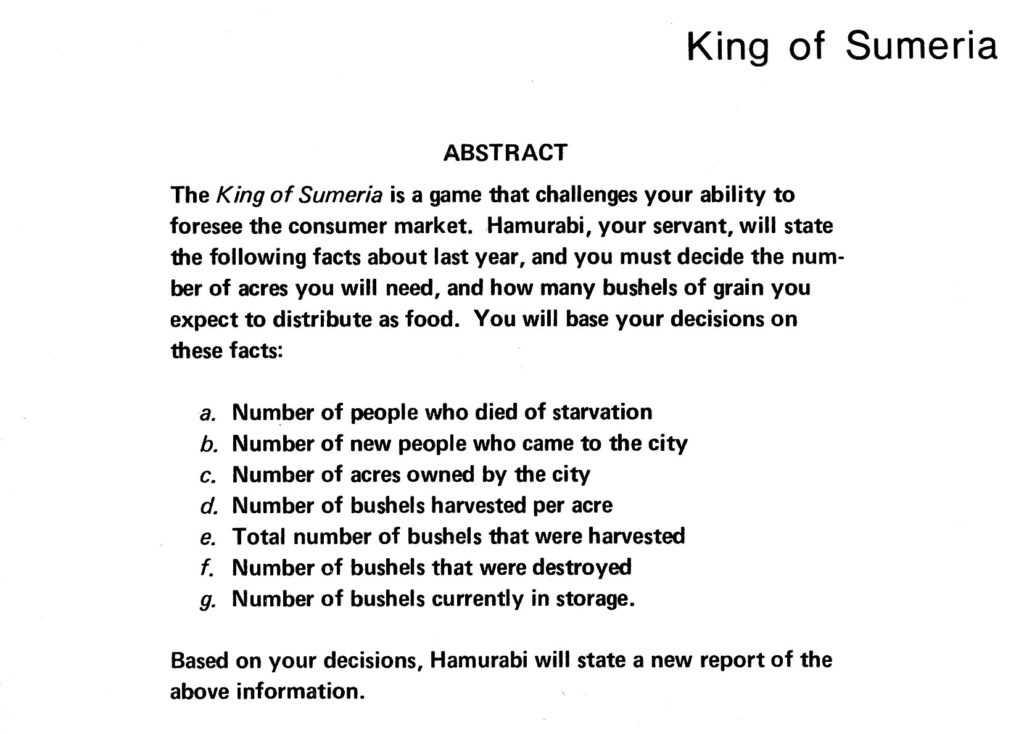
King Of Sumeria appeared in the DECUS Program Library Catalog as early as November 1969 under the title The Sumer Game, and under its proper name in DEC’s Focal-8 Demonstration Programs in July 1970.
But it would be a new employee who joined the DEC team in Massachusetts right around that same time, who would greatly increase the game’s visibility.
Hammurabi
In 1974, David H. Ahl founded Creative Computing, one of the most influential magazines during the early days of personal computers. But before that, he edited DEC’s magazine EDU, after joining DEC’s Education Marketing Group in 1970.
“Games were a good way to demonstrate computers to people who weren’t very tech savvy,” he told me. “Unlike colleges and universities, secondary schools had very small budgets for calculators and computers so they were looking at small configurations.”
But DEC didn’t offer BASIC on these low-end computers. “Consequently, I used many of the FOCAL programs that were around to demonstrate computers to secondary schools.” Which is how he came across games like King Of Sumeria.
As BASIC became more influential in the educational market, he began contracting people to develop BASIC compilers. Eventually he edited a collection of BASIC games called 101 Basic Computer Games, published by DEC in 1973.
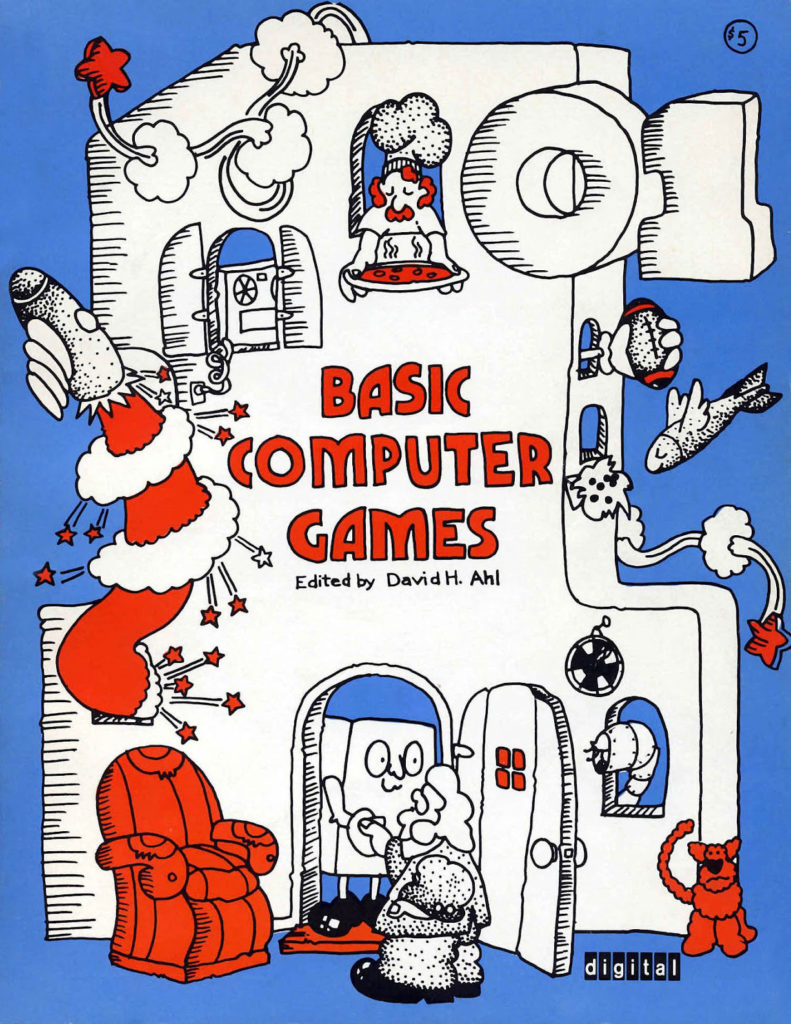
The book included a game called HMRABI. The book notes it was “translated from the original FOCAL program,” but it’s much more than a mere translation. For one thing, all the lines in the game were complete sentences again. And each cycle now began with the memorable phrase “I beg to report to you.”
HAMURABI: I BEG TO REPORT TO YOU, IN YEAR 1, 0 PEOPLE STARVED, 5 CAME TO THE CITY. POPULATION IS NOW 100 THE CITY NOW OWN 1000 ACRES. YOU HARVESTED 3 BUSHELS PER ACRE. RATS ATE 200 BUSHELS. YOU NOW HAVE 2800 BUSHELS IN STORE. LAND IS TRADING AT 17 BUSHELS PER ACRE. HOW MANY ACRES DO YOU WISH TO BUY? 20 HOW MANY BUSHELS DO YOU WISH TO FEED YOUR PEOPLE? 1900 HOW MANY ACRES DO YOU WISH TO PLAN WITH SEED? 1000 BUT YOU ONLY HAVE 100 PEOPLE TO TEND THE FIELDS. NOW THEN, HOW MANY ACRES DO YOU WISH TO PLANT WITH SEED? 990
The BASIC conversion also added colorful end-of-game assessements, ranging from “Charlemange, Disraeli, and Jefferson combined could not have done better” to “people would dearly like to see you assassinated but we all have our trivial problems.”
Ahl’s motivation for these changes was pretty simple: “A game like Lunar Lander doesn’t need much dialog, but role-playing and simulation games like Hammurabi benefit greatly from dialog, which makes the games
more interesting and fun,” and the end-game assessement “gives you something to try and better the next time you play the game.”
This became the most recognizable version of the game, thanks in part to the book being republished in 1978 as Basic Computer Games. “When I left DEC, they agreed that I could publish the book with the games converted to Microsoft Basic. That version was first published in January 1978 and went on to become the first million-selling computer book a few years later.” [See “2021 Update” below for an update about these sales figures.]

The 1978 printing renamed it from HMRABI to Hammurabi, with an important note about the missing “m”:
“This error has spread far and wide until a generation of students who have used this program now think that Hammurabi is the incorrect spelling.”
To this day, even the Wikipedia entry refers to the game as “Hamurabi.”
The thing that struck me most about Ahl’s version is the similarity between “I beg to report to you” and The Sumerian Game‘s “Sir, I am sorry to report.” Yet when asked, Ahl was completely unaware that a pre-DEC version ever existed. Much like the rest of the world.
So where did The Sumerian Game go? And how do we bring it back?
I Am Sorry To Report
Bruse Moncreiff passed away in 1985
Mabel Addis passed away in 2004.
William McKay passed away in 2012.
If any complete copies of this game still exist, no one alive seems to know where to find them. Despite a feature in LIFE and a mention in TIME in 1966, the game disappeared pretty quickly once funding ran out.
But it’s not all bad news. Dr. Richard L. Wing wrote up a Final Report on the game in 1967 that is extremely informative and available on Archive.org. It even includes an example printout of the first stage from the 1966 version!
And thanks to the heroic efforts of historian Devin Monnens — who managed to track down Mabel Addis’ daughter — we have additional documents, including a small set of slides a few printouts of the first stage circa 1964, which have been donated to the Strong Museum Of Play.
But what we don’t have is a complete set of slides, printouts from stages two or three, the source code, and any cassette tape audio. It appears that even IBM no longer has copies, unless they’re hidden in some archive no one alive is aware of.
The Sumerian Game might forever remain one of those obscure Holy Grails that only fans of history are aware of. But the least we can do is remember Mabel Addis.
2021 Update
Newly discovered documents have brought to light additional details that help clarify the game’s evolution from “Sumerian Game” to “Hamurabi,” in some cases even proving previous information to be incorrect.
The biggest breakthrough was the discovery of the actual program listing for the earliest version Doug Dyment’s King Of Sumeria, which was submitted to the DECUS Program Library as The Sumer Game. Reading this document, it becomes clear that the BASIC version that appears in David Ahl’s 101 BASIC was adapted from this DECUS version, not Dyment’s much more compact revision from a year or so later.
Surprisingly, the DECUS version includes the famous line “I beg to report!” I knew there had to be some direct connection between the version of that line in The Sumerian Game and in Hamurabi, and finally we have the missing link!
But just as one mystery was solved, another mystery springs up:
Fellow researcher Dale Geddes did a number of experiments running both version of Dyment’s code through PDP-8 set-ups, and determined that the longer version was still able to run just fine with 4K memory. So why did Dyment write a shorter version a year or so later? We each have our theories, but the true answer may be lost to time.
Needless to say, it’s unlikely that the misspelling of “Hamurabi” was due to space limitations, as it’s also present in the longer DECUS version.
Other corrections:
- The summary for the DEC program listing makes it clear that the “Hamurabi” in Dyment’s game is the name of your steward, not the player character as I’d previously misread. I’ve updated the article to reflect this.
- David Ahl may be misremembering how quickly his self-published revision of Basic Computer Games became a million-seller. He said it “went on to become the first million-selling computer book” a few years after 1978, but the February 1981 issue of Creative Computing reports that the combined sales of the book and its sequel, More Basic Computer Games, is 500,000 so far.
If you’d like to know more about the early history of storytelling in video games, please support my ongoing research on Patreon.
Sources
- The Production And Evaluation Of Three Computer-Based Economics Games For The Sixth Grade – Final Report by Richard L. Wing
- The Sumerian Game 50 Years Later: The Strange and Untold Story of the World’s Most Influential Text Simulation Game by Devin Monnens
- Projekt Sumerian Game: Digitale Rekonstruktion eines Spiels als Simulation eines Modells by Tobias Winnerling
- Jäger des verlorenen Spiels – IBM: The Sumerian Game by Tobias Winnerling
- Mabel Addis Mergardt (obituary)
- nyshistoricnewspapers.org, fultonsearch.org, archive.org
SPECIAL THANKS: David H. Ahl, Frank Cifaldi, Doug Dyment, Dale Geddes, Ethan Johnson, Devin Monnens, Alex Smith, and the Secret Writers Society.
Comments:
Join the discussion on my Patreon page!


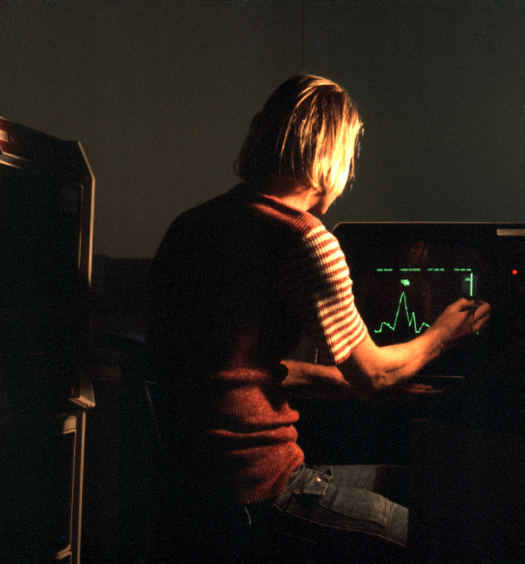








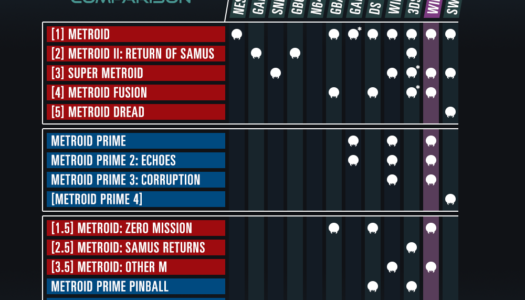
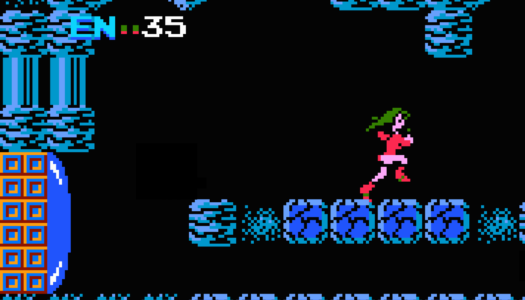
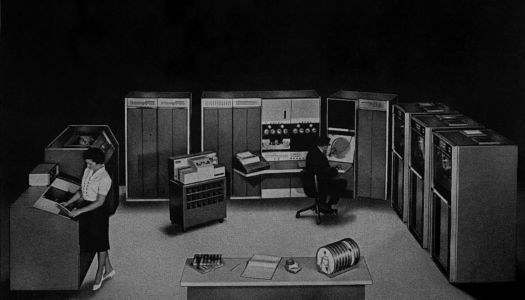
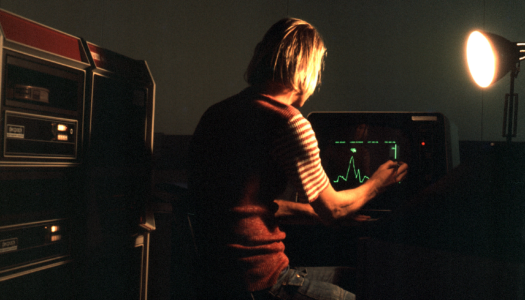
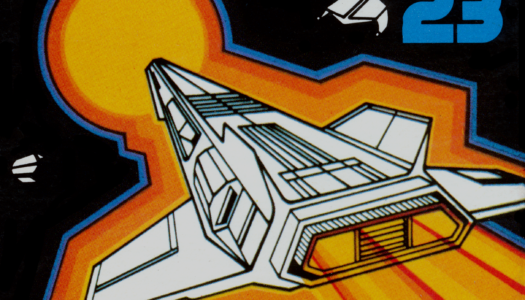

September 13, 2019
[…] The most important video game you never heard of ist die Geschichte eines Spiels für Schüler*innen, das eins der allerersten Computerspiele überhaupt war und bahnbrechend war – lange Zeit vor vielen anderen war es das erste, das Cutszenen enthielt. […]
October 3, 2019
[…] The Sumerian Game: The Most Important Video Game You’ve Never Heard Of […]
October 16, 2019
[…] Indeed the majority of game programs through the 1960s and early 70s – games like The Sumerian Game, Hunt the Wumpus, Star Trek – could only be displayed through the use of teletypes unless one […]
March 11, 2020
[…] 14 https://www.acriticalhit.com/sumerian-game-most-important-video-game-youve-never-heard/ […]
March 16, 2020
[…] standards, nothing that was original or unique to computers, while 101 BASIC featured games like “Hamurabi” and “Rocket” (aka […]
May 14, 2021
[…] Kate (9. September 2019). “Das sumerische Spiel: Das wichtigste Videospiel, von dem Sie noch nie gehört haben”. Ein kritischer Treffer. Abgerufen 10. September […]